Atmosphere-Transported Emerging and Persistent Contaminants (EPCs) in Rainfall and Throughfall: Insights from a Rural Site in Northern Thailand
Abstract
:1. Introduction
2. Materials and Methods
2.1. Study Area
2.2. Sampling
2.3. Analyses
2.3.1. Compounds Considered
2.3.2. Analytical Procedures
2.3.3. Quality Assurance/Quality Control (QA/QC)
3. Results
3.1. Throughfall Relationship with Selected Water Quality Parameters
3.2. EPC Concentrations
3.2.1. Rainfall and Throughfall
3.2.2. Surface Waters
4. Discussion
4.1. Comparison with Other Studies Worldwide
4.2. Trends at the Thailand Site
4.3. Uncertainties for 4-nitrophenol and Experimental Limitations
5. Conclusions
Supplementary Materials
Author Contributions
Funding
Institutional Review Board Statement
Informed Consent Statement
Data Availability Statement
Conflicts of Interest
References
- Burri, N.M.; Weatherl, R.; Moeck, C.; Schirmer, M. A review of threats to groundwater quality in the anthropocene. Sci. Total Environ. 2019, 684, 136–154. [Google Scholar] [CrossRef] [PubMed]
- Kumar, M.; Snow, D.D.; Honda, R. (Eds.) Emerging Issues in the Water Environment During Anthropocene: A South East Asian Perspective; Springer: Berlin/Heidelberg, Germany, 2020; pp. 1–365. [Google Scholar]
- Noguera-Oviedo, K.; Aga, D.S. Lessons learned from more than two decades of research on emerging contaminants in the environment. J. Hazard. Mater. 2016, 316, 242–251. [Google Scholar] [CrossRef] [PubMed]
- Sauvé, S.; Desrosiers, M. A review of what is an emerging contaminant. Chem. Cent. J. 2014, 8, 15. [Google Scholar] [CrossRef] [PubMed]
- Gavrilescu, M.; Demnerová, K.; Aamand, J.; Agathos, S.; Fava, F. Emerging pollutants in the environment: Present and future challenges in biomonitoring, ecological risks and bioremediation. New Biotechnol. 2015, 32, 147–156. [Google Scholar] [CrossRef]
- Prieto-Rodriguez, L.; Miralles-Cuevas, S.; Oller, I.; Agüera, A.; Puma, G.L.; Malato, S. Treatment of emerging contaminants in wastewater treatment plants (WWTP) effluents by solar photocatalysis using low TiO2 concentrations. J. Hazard. Mater. 2012, 211, 131–137. [Google Scholar] [CrossRef]
- Naidu, R.; Espana, V.A.A.; Liu, Y.; Jit, J. Emerging contaminants in the environment: Risk-based analysis for better management. Chemosphere 2016, 154, 350–357. [Google Scholar] [CrossRef]
- Gwenzi, W.; Dunjana, N.; Pisa, C.; Tauro, T.; Nyamadzawo, G. Water quality and public health risks associated with roof rainwater harvesting systems for potable supply: Review and perspectives. Sustain. Water Qual. Ecol. 2015, 6, 107–118. [Google Scholar] [CrossRef]
- Sánchez, A.; Cohim, E.; Kalid, R. A review on physicochemical and microbiological contamination of roof-harvested rainwater in urban areas. Sustain. Water Qual. Ecol. 2015, 6, 119–137. [Google Scholar] [CrossRef]
- Deng, Y. Pollution in rainwater harvesting: A challenge for sustainability and resilience of urban agriculture. J. Hazard. Mater. Lett. 2021, 2, 100037. [Google Scholar] [CrossRef]
- Barroso, P.J.; Santos, J.L.; Martín, J.; Aparicio, I.; Alonso, E. Emerging contaminants in the atmosphere: Analysis, occurrence and future challenges. Crit. Rev. Environ. Sci. Technol. 2019, 49, 104–171. [Google Scholar] [CrossRef]
- Kim, S.-K.; Kannan, K. Perfluorinated acids in air, rain, Snow, surface runoff, and lakes: Relative importance of pathways to contamination of urban lakes. Environ. Sci. Technol. 2007, 41, 8328–8334. [Google Scholar] [CrossRef]
- Alfonso, M.B.; Arias, A.H.; Ronda, A.C.; Piccolo, M.C. Continental microplastics: Presence, features, and environmental transport pathways. Sci. Total Environ. 2021, 799, 149447. [Google Scholar] [CrossRef]
- Abbasi, T.; Abbasi, S.A. Sources of pollution in rooftop rainwater harvesting systems and their control. Crit. Rev. Environ. Sci. Technol. 2011, 41, 2097–2167. [Google Scholar] [CrossRef]
- Pamuru, S.T.; Forgione, E.; Croft, K.; Kjellerup, B.V.; Davis, A.P. Chemical characterization of urban stormwater: Traditional and emerging contaminants. Sci. Total Environ. 2021, 813, 151887. [Google Scholar] [CrossRef]
- Potter, A. Atmospheric dry deposition of legacy and emerging per-and polyfluoroalkyl substances (PFAS) in North Carolina. In Proceedings of the 2021 Emerging Contaminants in the Environment Conference (EPCEPC21), Champaign, IL, USA, 27–28 April 2021. [Google Scholar]
- Wang, Q.; Guo, S.; Hou, Z.; Lin, H.; Liang, H.; Wang, L.; Luo, Y.; Ren, H. Rainfall facilitates the transmission and proliferation of antibiotic resistance genes from ambient air to soil. Sci. Total Environ. 2021, 799, 149260. [Google Scholar] [CrossRef]
- Seiber, J.N.; Cahill, T.M. Pesticides, Organic Contaminants, and Pathogens in Air: Chemodynamics, Health Effects, Sampling, and Analysis; Taylor & Francis: Abingdon, UK, 2022; p. 260. [Google Scholar]
- Rodrigo, A.; Àvila, A.; Rodà, F. The chemistry of precipitation, throughfall and stemflow in two holm oak (Quercus ilex L.) forests under a contrasted pollution environment in NE Spain. Sci. Total Environ. 2003, 305, 195–205. [Google Scholar] [CrossRef]
- Ziegler, A.D.; Giambelluca, T.W.; Nullet, M.A.; Sutherland, R.A.; Tantasarin, C.; Vogler, J.B.; Negishi, J.N. Throughfall in an evergreen-dominated forest stand in northern Thailand: Comparison of mobile and stationary methods. Agric. For. Meteorol. 2009, 149, 373–384. [Google Scholar] [CrossRef]
- Hansen, K.; Draaijers, G.P.; Ivens, W.P.; Gundersen, P.; Vanleeuwen, N. Concentration variations in rain and canopy throughfall collected sequentially during individual rain events. Atmos. Environ. 1994, 28, 3195–3205. [Google Scholar] [CrossRef]
- Draaijers, G.; Erisman, J.; Leeuwen, N.; Römer, F.; Winkel, B.; Veltkamp, A.; Vermeulen, A.; Wyers, G. The impact of canopy exchange on differences observed between atmospheric deposition and throughfall fluxes. Atmos. Environ. 1997, 31, 387–397. [Google Scholar] [CrossRef]
- Návar, J.; González, J.M.; Gonzalez, H. Gross precipitation and throughfall chemistry in legume species planted in Northeastern México. Plant Soil 2008, 318, 15–26. [Google Scholar] [CrossRef]
- Polkowska, Ż.; Skarżyńska, K.; Górecki, T.; Namieśnik, J. Formaldehyde in various forms of atmospheric precipitation and deposition from highly urbanized regions. J. Atmos. Chem. 2006, 53, 211–236. [Google Scholar] [CrossRef]
- Van Stan, J.T.; Ponette-González, A.G.; Swanson, T.; Weathers, K.C. Throughfall and stemflow are major hydrologic highways for particulate traffic through tree canopies. Front. Ecol. Environ. 2021, 19, 404–410. [Google Scholar] [CrossRef]
- McGrath, B.; Sangawongse, S.; Thaikatoo, D.; Corte, M.B. The architecture of the metacity: Land use change, patch dynamics and urban form in chiang Mai, Thailand. Urban Plan. 2017, 2, 53–71. [Google Scholar] [CrossRef]
- Gugino, H.; Irvine, K.; Ngern-klun, R.; Sukontason, K.; Sukontason, K.; Prangkio, C.; Thunyapar, P. Impacts of the urban environment on area water source: The Klong Mae Kha-Chiang Mai, Thailand. In Proceedings of the Fourth International Symposium on Southeast Asian Water Environment, Bangkok, Thailand, 6–8 December 2006; pp. 85–88. [Google Scholar]
- Itayama, T.; Hawkins, P.R.; Leelahakriengkrai, P.; Kullasoot, S.; Whangchai, N.; Chitmanat, C.; Kawabata, Z.I. Bioassessment of dry season water quality in the Ping River around Chiang Mai City, Thailand. Chiang Mai J. Sci. 2015, 42, 349–366. [Google Scholar]
- Vanwambeke, S.O.; Somboon, P.; Lambin, E.F. Rural transformation and land use change in northern Thailand. J. Land Use Sci. 2007, 2, 1–29. [Google Scholar] [CrossRef]
- Harnpicharnchai, K.; Chaiear, N.; Charerntanyarak, L. Residues of organophosphate pesticides used in vegetable cultivation in ambient air, surface water and soil in Bueng Niam Subdistrict, Khon Kaen, Thailand. Southeast Asian J. Trop. Med. Public Health 2013, 44, 1088–1097. [Google Scholar]
- Chuah, C.J.; Mukhaidin, N.; Choy, S.H.; Smith, G.J.; Mendenhall, I.H.; Lim, Y.A.; Ziegler, A.D. Prevalence of Cryptosporidium and Giardia in the water resources of the Kuang River catchment, Northern Thailand. Sci. Total Environ. 2016, 562, 701–713. [Google Scholar] [CrossRef]
- Chuah, C.J.; Ziegler, A.D. Temporal variability of faecal contamination from On-Site sanitation systems in the groundwater of Northern Thailand. Environ. Manag. 2018, 61, 939–953. [Google Scholar] [CrossRef]
- Ziegler, A.D.; Benner, S.G.; Tantasirin, C.; Wood, S.H.; Sutherland, R.A.; Sidle, R.C.; Jachowski, N.; Nullet, M.A.; Xi, L.X.; Snidvongs, A.; et al. Turbidity-based sediment monitoring in northern Thailand: Hysteresis, variability, and uncertainty. J. Hydrol. 2014, 519, 2020–2039. [Google Scholar] [CrossRef]
- Sidle, R.C.; Ziegler, A.D. The canopy interception–landslide initiation conundrum: Insight from a tropical secondary forest in northern Thailand. Hydrol. Earth Syst. Sci. 2017, 21, 651–667. [Google Scholar] [CrossRef]
- Wood, S.H.; Ziegler, A.D. Floodplain sediment from a 30-year-recurrence flood in 2005 of the Ping River in northern Thailand. Hydrol. Earth Syst. Sci. Discuss. 2007, 4, 3839–3868. [Google Scholar]
- Rippen, G.; Zietz, E.; Frank, R.; Knacker, T.; Klöpffer, W. Do airborne nitrophenols contribute to forest decline? Environ. Technol. Lett. 1987, 8, 475–482. [Google Scholar] [CrossRef]
- Richartz, H.; Reischl, A.; Trautner, F.; Hutzinger, O. Nitrated phenols in fog. Atmos. Environ. Gen. Top. 1990, 24, 3067–3071. [Google Scholar] [CrossRef]
- Levsen, K.; Behnert, S.; Mussmann, P.; Raabe, M.; Priess, B. Organic compounds in cloud and rain water. Int. J. Environ. Anal. Chem. 1993, 52, 87–97. [Google Scholar] [CrossRef]
- Shussler, W.; Nitschke, L. Nitrophenols in precipitation. Chemosphere 2001, 42, 277. [Google Scholar] [CrossRef]
- Hofmann, D.; Hartmann, F.; Herrmann, H. Analysis of nitrophenols in cloud water with a miniaturized light-phase rotary perforator and HPLC-MS. Anal. Bioanal. Chem. 2008, 391, 161–169. [Google Scholar] [CrossRef]
- Polyakova, O.V.; Artaev, V.B.; Lebedev, T. Priority and emerging pollutants in the Moscow rain. Sci. Total Environ. 2018, 645, 1126–1134. [Google Scholar] [CrossRef]
- Ganranoo, L.; Mishra, S.K.; Azad, A.K.; Shigihara, A.; Dasgupta, P.K.; Breitbach, Z.S.; Armstrong, D.W.; Grudpan, K.; Rappenglueck, B. Measurement of Nitrophenols in Rain and Air by Two-Dimensional Liquid Chromatography−Chemically Active Liquid Core Waveguide Spectrometry. Anal. Chem. 2010, 82, 5838–5843. [Google Scholar] [CrossRef]
- Levsen, K.; Behnert, S.; Prieß, B.; Svoboda, M.; Winkeler, H.-D.; Zietlow, J. Organic compounds in precipitation. Chemosphere 1990, 21, 1037–1061. [Google Scholar] [CrossRef]
- Belloli, R.; Bolzacchini, E.; Clerici, L.; Rindone, B.; Sesana, G.; Librando, V. Nitrophenols in air and rainwater. Environ. Eng. Sci. 2006, 23, 405–415. [Google Scholar] [CrossRef]
- Bossi, R.; Vejrup, K.; Mogensen, B.; Asman, W. Analysis of polar pesticides in rainwater in Denmark by liquid chromatography–tandem mass spectrometry. J. Chromatogr. A 2002, 957, 27–36. [Google Scholar] [CrossRef] [PubMed]
- Harrison, M.A.; Barra, S.; Borghesi, D.; Vione, D.; Arsene, C.; Olariu, R.I. Nitrated phenols in the atmosphere: A review. Atmos. Environ. 2005, 39, 231–248. [Google Scholar] [CrossRef]
- Natangelo, M.; Mangiapan, S.; Bagnati, R.; Benfenati, E.; Fanelli, R. Increased concentrations of nitrophenols in leaves from a damaged forestal site. Chemosphere 1999, 38, 1495–1503. [Google Scholar] [CrossRef]
- Schwarzenbach, R.P.; Stierli, R.; Folsom, B.R.; Zeyer, J. Compound properties relevant for assessing the environmental partitioning of nitrophenols. Environ. Sci. Technol. 1988, 22, 83–92. [Google Scholar] [CrossRef] [PubMed]
- Li, S.; Wen, J.; He, B.; Wang, J.; Hu, X.; Liu, J. Occurrence of caffeine in the freshwater environment: Implications for ecopharmacovigilance. Environ. Pollut. 2020, 263, 114371. [Google Scholar] [CrossRef] [PubMed]
- Sidhu, J.P.S.; Ahmed, W.; Gernjak, W.; Aryal, R.; McCarthy, D.; Palmer, A.; Kolotelo, P.; Toze, S. Sewage pollution in urban stormwater runoff as evident from the widespread presence of multiple microbial and chemical source tracking markers. Sci. Total Environ. 2013, 463–464, 488–496. [Google Scholar] [CrossRef]
- Liu, N.; Jin, X.; Yan, Z.; Luo, Y.; Feng, C.; Fu, Z.; Tang, Z.; Wu, F.; Giesy, J.P. Occurrence and multiple-level ecological risk assessment of pharmaceuticals and personal care products (PPCPs) in two shallow lakes of China. Environ. Sci. Eur. 2020, 32, 27. [Google Scholar] [CrossRef]
- You, L.; Nguyen, V.T.; Pal, A.; Chen, H.; He, Y.; Reinhard, M.; Gin, K.Y.-H. Investigation of pharmaceuticals, personal care products and endocrine disrupting chemicals in a tropical urban catchment and the influence of environmental factors. Sci. Total Environ. 2015, 536, 955–963. [Google Scholar] [CrossRef]
- Tran, N.H.; Reinhard, M.; Khan, E.; Chen, H.; Nguyen, V.T.; Li, Y.; Goh, S.G.; Nguyen, Q.; Saeidi, N.; Gin, K.Y.-H. Emerging contaminants in wastewater, stormwater runoff, and surface water: Application as chemical markers for diffuse sources. Sci. Total Environ. 2019, 676, 252–267. [Google Scholar] [CrossRef]
- Waso, M.; Ndlovu, T.; Dobrowsky, P.H.; Khan, S.; Khan, W. Presence of microbial and chemical source tracking markers in roof-harvested rainwater and catchment systems for the detection of fecal contamination. Environ. Sci. Pollut. Res. 2016, 23, 16987–17001. [Google Scholar] [CrossRef]
- Waso, M. Identifying the Primary Microbial and Chemical Source Tracking Markers in Harvested Rainwater for the Detection of Faecal Contamination. Ph.D. Thesis, University of Stellenbosch, SA, Stellenbosch, South Africa, 2017. Available online: https://core.ac.uk/download/pdf/188219886.pdf (accessed on 30 September 2023).
- Burant, A.; Selbig, W.; Furlong, E.T.; Higgins, C.P. Trace organic contaminants in urban runoff: Associations with urban land-use. Environ. Pollut. 2018, 242, 2068–2077. [Google Scholar] [CrossRef] [PubMed]
- Fairbairn, D.J.; Elliott, S.M.; Kiesling, R.L.; Schoenfuss, H.L.; Ferrey, M.L.; Westerhoff, B.M. Contaminants of emerging concern in urban stormwater: Spatiotemporal patterns and removal by iron-enhanced sand filters (IESFs). Water Res. 2018, 145, 332–345. [Google Scholar] [CrossRef] [PubMed]
- González-Alonso, S.; Merino, L.M.; Esteban, S.; de Alda, M.L.; Barceló, D.; Durán, J.J.; López-Martínez, J.; Aceña, J.; Pérez, S.; Mastroianni, N.; et al. Occurrence of pharmaceutical, recreational and psychotropic drug residues in surface water on the northern Antarctic Peninsula region. Environ. Pollut. 2017, 229, 241–254. [Google Scholar] [CrossRef] [PubMed]
- Mihajlović, I.; Fries, E. Atmospheric deposition of chlorinated organophosphate flame retardants (OFR) onto soils. Atmospheric Environ. 2012, 56, 177–183. [Google Scholar] [CrossRef]
- Shi, Y.; Gao, L.; Li, W.; Wang, Y.; Liu, J.; Cai, Y. Occurrence, distribution and seasonal variation of organophosphate flame retardants and plasticizers in urban surface water in Beijing, China. Environ. Pollut. 2016, 209, 1–10. [Google Scholar] [CrossRef]
- Regnery, J.; Püttmann, W. Seasonal fluctuations of organophosphate concentrations in precipitation and storm water runoff. Chemosphere 2010, 78, 958–964. [Google Scholar] [CrossRef]
- Regnery, J.; Püttmann, W. Occurrence and fate of organophosphorus flame retardants and plasticizers in urban and remote surface waters in Germany. Water Res. 2010, 44, 4097–4104. [Google Scholar] [CrossRef]
- Marklund, A.; Andersson, B.; Haglund, P. Traffic as a Source of Organophosphorus Flame Retardants and Plasticizers in Snow. Environ. Sci. Technol. 2005, 39, 3555–3562. [Google Scholar] [CrossRef]
- Bacaloni, A.; Cucci, F.; Guarino, C.; Nazzari, M.; Samperi, R.; Laganà, A. Occurrence of Organophosphorus Flame Retardant and Plasticizers in Three Volcanic Lakes of Central Italy. Environ. Sci. Technol. 2008, 42, 1898–1903. [Google Scholar] [CrossRef]
- Fries, E.; Püttmann, W. Occurrence of organophosphate esters in surface water and groundwater in Germany. J. Environ. Monit. 2001, 3, 621–626. [Google Scholar] [CrossRef]
- Fries, E.; Püttmann, W. Monitoring of the three organophosphate esters TBP, TCEP and TBEP in river water and ground water (Oder, Germany). J. Environ. Monit. 2003, 5, 346–352. [Google Scholar] [CrossRef] [PubMed]
- Laohaudomchok, W.; Nankongnab, N.; Siriruttanapruk, S.; Klaimala, P.; Lianchamroon, W.; Ousap, P.; Jatiket, M.; Kajitvichyanukul, P.; Kitana, N.; Siriwong, W.; et al. Pesticide use in Thailand: Current situation, health risks, and gaps in research and policy. Hum. Ecol. Risk Assess. Int. J. 2020, 27, 1147–1169. [Google Scholar] [CrossRef] [PubMed]
- Sakai, M. Acute toxic tests of rainwater samples using Daphnia magna. Ecotoxicol. Environ. Saf. 2006, 64, 215–220. [Google Scholar] [CrossRef] [PubMed]
- Nohara, S.; Hanazato, T.; Iwakuma, T. Pesticide Residue Flux from Rainwater into Lake Nakanuma in the Rainy Season. Jpn. J. Limnol. 1997, 58, 385–393. [Google Scholar] [CrossRef]
- Suzuki, S.; Otani, T.; Iwasaki, S.; Ito, K.; Omura, H.; Tanaka, Y. Monitoring of 15 Pesticides in Rainwater in Utsunomiya, Eastern Japan, 1999–2001. J. Pestic. Sci. 2003, 28, 1–7. [Google Scholar] [CrossRef]
- Haraguchi, K.; Kitamura, E.; Yamashita, T.; Kido, A. Simultaneous determination of trace pesticides in urban precipitation. Atmos. Environ. 1995, 29, 247–253. [Google Scholar] [CrossRef]
- Chau, N.D.G.; Sebesvari, Z.; Amelung, W.; Renaud, F.G. Pesticide pollution of multiple drinking water sources in the Mekong Delta, Vietnam: Evidence from two provinces. Environ. Sci. Pollut. Res. 2015, 22, 9042–9058. [Google Scholar] [CrossRef]
- Miller, S.M.; Sweet, C.W.; DePinto, J.V.; Hornbuckle, K.C. Atrazine and Nutrients in Precipitation: Results from the Lake Michigan Mass Balance Study. Environ. Sci. Technol. 1999, 34, 55–61. [Google Scholar] [CrossRef]
- Mast, M.A.; Foreman, W.T.; Skaates, S.V. Current-Use Pesticides and Organochlorine Compounds in Precipitation and Lake Sediment from Two High-Elevation National Parks in the Western United States. Arch. Environ. Contam. Toxicol. 2007, 52, 294–305. [Google Scholar] [CrossRef]
- Villagómez-Márquez, N.; Abrell, L.; Foley, T.; Ramírez-Andreotta, M.D. Organic micropollutants measured in roof-harvested rainwater from rural and urban environmental justice communities in Arizona. Sci. Total Environ. 2023, 876, 162662. [Google Scholar] [CrossRef]
- Albanis, T.; Hela, D.; Sakellarides, T.; Konstantinou, I. Monitoring of pesticide residues and their metabolites in surface and underground waters of Imathia (N. Greece) by means of solid-phase extraction disks and gas chromatography. J. Chromatogr. A 1998, 823, 59–71. [Google Scholar] [CrossRef] [PubMed]
- Trautner, F.; Huber, K.; Niessner, R. Appearance and concentration ranges of atrazine in spring time cloud and rainwater from the Vosges France. J. Aerosol Sci. 1992, 23, 999–1002. [Google Scholar] [CrossRef]
- Bester, K.; Hühnerfuss, H.; Neudorf, B.; Thiemann, W. Atmospheric deposition of triazine herbicides in Northern Germany and the German Bight (North Sea). Chemosphere 1995, 30, 1639–1653. [Google Scholar] [CrossRef]
- Chevreuil, M.; Garmouma, M. Occurrence of triazines in the atmospheric fallout on the catchment basin of the River Marne (France). Chemosphere 1993, 27, 1605–1608. [Google Scholar] [CrossRef]
- Drevenkar, V.; Fingler, S.; Mendaš, G.; Stipičević, S.; Vasilić, Z. Levels of atrazine and simazine in waters in the rural and urban areas of North-West Croatia. Int. J. Environ. Anal. Chem. 2004, 84, 207–216. [Google Scholar] [CrossRef]
- Asman, W.A.; Jørgensen, A.; Bossi, R.; Vejrup, K.V.; Mogensen, B.B.; Glasius, M. Wet deposition of pesticides and nitrophenols at two sites in Denmark: Measurements and contributions from regional sources. Chemosphere 2005, 59, 1023–1031. [Google Scholar] [CrossRef]
- Kreuger, J.; Adielsson, S.; Kylin, H. Monitoring of Pesticides in Atmospheric Deposition in Sweden 2002–2005: Report to Swedish Environmental Protection Agency Contract No. 211 0543; Technical Report 103; Swedish University of Agricultural Sciences, Department Soil Sciences, Division of Water Quality Management: Uppsala, Sweden, 2006. [Google Scholar]
- Buser, H.R. Atrazine and other s-triazine herbicides in lakes and in rain in Switzerland. Environ. Sci. Technol. 1990, 24, 1049–1058. [Google Scholar] [CrossRef]
- Siebers, J.; Gottschild, D.; Nolting, H.-G. Pesticides in precipitation in Northern Germany. Chemosphere 1994, 28, 1559–1570. [Google Scholar] [CrossRef]
- Bucheli, T.D.; Müller, S.R.; Heberle, S.; Schwarzenbach, R.P. Occurrence and Behavior of Pesticides in Rainwater, Roof Runoff, and Artificial Stormwater Infiltration. Environ. Sci. Technol. 1998, 32, 3457–3464. [Google Scholar] [CrossRef]
- Scheyer, A.; Morville, S.; Mirabel, P.; Millet, M. Analysis of trace levels of pesticides in rainwater using SPME and GC–tandem mass spectrometry. Anal. Bioanal. Chem. 2005, 384, 475–487. [Google Scholar] [CrossRef]
- Wu, T.L. Atrazine residues in estuarine water and the aerial deposition of atrazine into Rhode River, Maryland. Water Air Soil Pollut. 1981, 15, 173–184. [Google Scholar] [CrossRef]
- Richards, R.P.; Kramer, J.W.; Baker, D.B.; Krieger, K.A. Pesticides in rainwater in the northeastern United States. Nature 1987, 327, 129–131. [Google Scholar] [CrossRef]
- Hall, J.C.; Van Deynze, T.D.; Struger, J.; Chan, C.H. Enzyme immunoassay based survey of precipitation and surface water for the presence of atrazine, metolachlor and 2,4-D. J. Environ. Sci. Health 1993, 28, 577–598. [Google Scholar] [CrossRef] [PubMed]
- Trevisan, M.; Montepiani, C.; Ragozza, L.; Bartoletti, C.; Ioannilli, E.; Del Re, A. Pesticides in rainfall and air in Italy. Environ. Pollut. 1993, 80, 31–39. [Google Scholar] [CrossRef] [PubMed]
- Dankwardt, A.; Wüst, S.; Elling, W.; Thurman, E.M.; Hock, B. Determination of atrazine in rainfall and surface water by enzyme immunoassay. Environ. Sci. Pollut. Res. 1994, 1, 196–204. [Google Scholar] [CrossRef]
- Nations, B.K.; Hallberg, G.R. Pesticides in Iowa precipitation. J. Environ. Qual. 1992, 21, 486–492. [Google Scholar] [CrossRef]
- Hatfield, J.L.; Wesley, C.K.; Prueger, J.H.; Pfeiffer, R.L. Herbicide and Nitrate Distribution in Central Iowa Rainfall. J. Environ. Qual. 1996, 25, 259–264. [Google Scholar] [CrossRef]
- Goolsby, D.A.; Thurman, E.M.; Pomes, M.L.; Meyer, M.T.; Battaglin, W.A. Herbicides and Their Metabolites in Rainfall: Origin, Transport, and Deposition Patterns across the Midwestern and Northeastern United States, 1990−1991. Environ. Sci. Technol. 1997, 31, 1325–1333. [Google Scholar] [CrossRef]
- Alonso, L.L.; Demetrio, P.M.; Etchegoyen, M.A.; Marino, D.J. Glyphosate and atrazine in rainfall and soils in agroproductive areas of the pampas region in Argentina. Sci. Total Environ. 2018, 645, 89–96. [Google Scholar] [CrossRef]
- Quaghebeur, D.; De Smet, B.; De Wulf, E.; Steurbaut, W. Pesticides in rainwater in Flanders, Belgium: Results from the monitoring program 1997–2001. J. Environ. Monit. 2004, 6, 182–190. [Google Scholar] [CrossRef]
- Lode, O.; Eklo, O.M.; Holen, B.; Svensen, A.; Johnsen, A.M. Pesticides in precipitation in Norway. Sci. Total Environ. 1995, 160–161, 421–431. [Google Scholar] [CrossRef]
- Dörfler, U.; Scheunert, I. S-triazine herbicides in rainwater with special reference to the situation in Germany. Chemosphere 1997, 35, 77–85. [Google Scholar] [CrossRef]
- Van Maanen, J.M.S.; de Vaan, M.A.J.; Veldstra, A.W.F.; Hendrix, W.P.A.M. Pesticides and nitrate in groundwater and rainwater in the Province of Limburg in The Netherlands. Environ. Monit. Assess. 2001, 72, 95–114. [Google Scholar] [CrossRef]
- Potter, T.L.; Coffin, A.W. Assessing pesticide wet deposition risk within a small agricultural watershed in the Southeastern Coastal Plain (USA). Sci. Total Environ. 2017, 580, 158–167. [Google Scholar] [CrossRef]
- Hirvi, J.P.; Rekolainen, S. Pesticides in precipitation and surface water in Finland. In: Arne Helweg (Ed.), Pesticides in Precipitation and Surface Water (Nordic seminar). TemaNord 1995, 558, 12–18. [Google Scholar]
- Rawn, D.F.K.; Halldorson, T.H.J.; Lawson, B.D.; Muir, D.C.G. A Multi-Year Study of Four Herbicides in Air and Precipitation from a Small Prairie Watershed. J. Environ. Qual. 1999, 28, 898–906. [Google Scholar] [CrossRef]
- Scheyer, A.; Morville, S.; Mirabel, P.; Millet, M. Pesticides analysed in rainwater in Alsace region (Eastern France): Comparison between urban and rural sites. Atmos. Environ. 2007, 41, 7241–7252. [Google Scholar] [CrossRef]
- Dubus, I.; Hollis, J.; Brown, C. Pesticides in rainfall in Europe. Environ. Pollut. 2000, 110, 331–344. [Google Scholar] [CrossRef]
- Sandmann, E.R.; de Beer, P.R.; van Dyk, L.P. Atmospheric pollution by auxin-type herbicides in Tala Valley, Natal. Chemosphere 1991, 22, 137–145. [Google Scholar] [CrossRef]
- Hill, B.D.; Harker, K.N.; Hasselback, P.; Inaba, D.J.; Byers, S.D.; Moyer, J.R. Herbicides in Alberta Rainfall as Affected by Location, Use and Season: 1999 to 2000. Water Qual. Res. J. 2002, 37, 515–542. [Google Scholar] [CrossRef]
- Datel, J.V.; Hrabankova, A. Pharmaceuticals Load in the Svihov Water Reservoir (Czech Republic) and Impacts on Quality of Treated Drinking Water. Water 2020, 12, 1387. [Google Scholar] [CrossRef]
- Peña-Guzmán, C.; Ulloa-Sánchez, S.; Mora, K.; Helena-Bustos, R.; Lopez-Barrera, E.; Alvarez, J.; Rodriguez-Pinzón, M. Emerging pollutants in the urban water cycle in Latin America: A review of the current literature. J. Environ. Manag. 2019, 237, 408–423. [Google Scholar] [CrossRef] [PubMed]
- Atkinson, R.; Guicherit, R.; Hites, R.A.; Palm, W.-U.; Seiber, J.N.; de Voogt, P. Transformations of Pesticides in the Atmosphere: A State of the Art. Water Air Soil Pollut. 1999, 115, 219–243. [Google Scholar] [CrossRef]
- Unsworth, J.B.; Wauchope, R.D.; Klein, A.-W.; Dorn, E.; Zeeh, B.; Yeh, S.M.; Akerblom, M.; Racke, K.D.; Rubin, B. Significance of the Long Range Transport of Pesticides in the Atmosphere. Pure Appl. Chem. 1999, 71, 1359–1383. [Google Scholar] [CrossRef]
- Tong, X.; Mohapatra, S.; Zhang, J.; Tran, N.H.; You, L.; He, Y.; Gin, K.Y.-H. Source, fate, transport and modelling of selected emerging contaminants in the aquatic environment: Current status and future perspectives. Water Res. 2022, 217, 118418. [Google Scholar] [CrossRef]
- Corrêa, J.M.M.; Sanson, A.L.; Machado, C.F.; Aquino, S.F.; Afonso, R.J.C.F. Occurrence of contaminants of emerging concern in surface waters from Paraopeba River Basin in Brazil: Seasonal changes and risk assessment. Environ. Sci. Pollut. Res. 2021, 28, 30242–30254. [Google Scholar] [CrossRef]
- Ebele, A.J.; Oluseyi, T.; Drage, D.S.; Harrad, S.; Abdallah, M.A.-E. Occurrence, seasonal variation and human exposure to pharmaceuticals and personal care products in surface water, groundwater and drinking water in Lagos State, Nigeria. Emerg. Contam. 2020, 6, 124–132. [Google Scholar] [CrossRef]
- Sun, J.; Mu, Q.; Kimura, H.; Murugadoss, V.; He, M.; Du, W.; Hou, C. Oxidative degradation of phenols and substituted phenols in the water and atmosphere: A review. Adv. Compos. Hybrid Mater. 2022, 5, 627–640. [Google Scholar] [CrossRef]
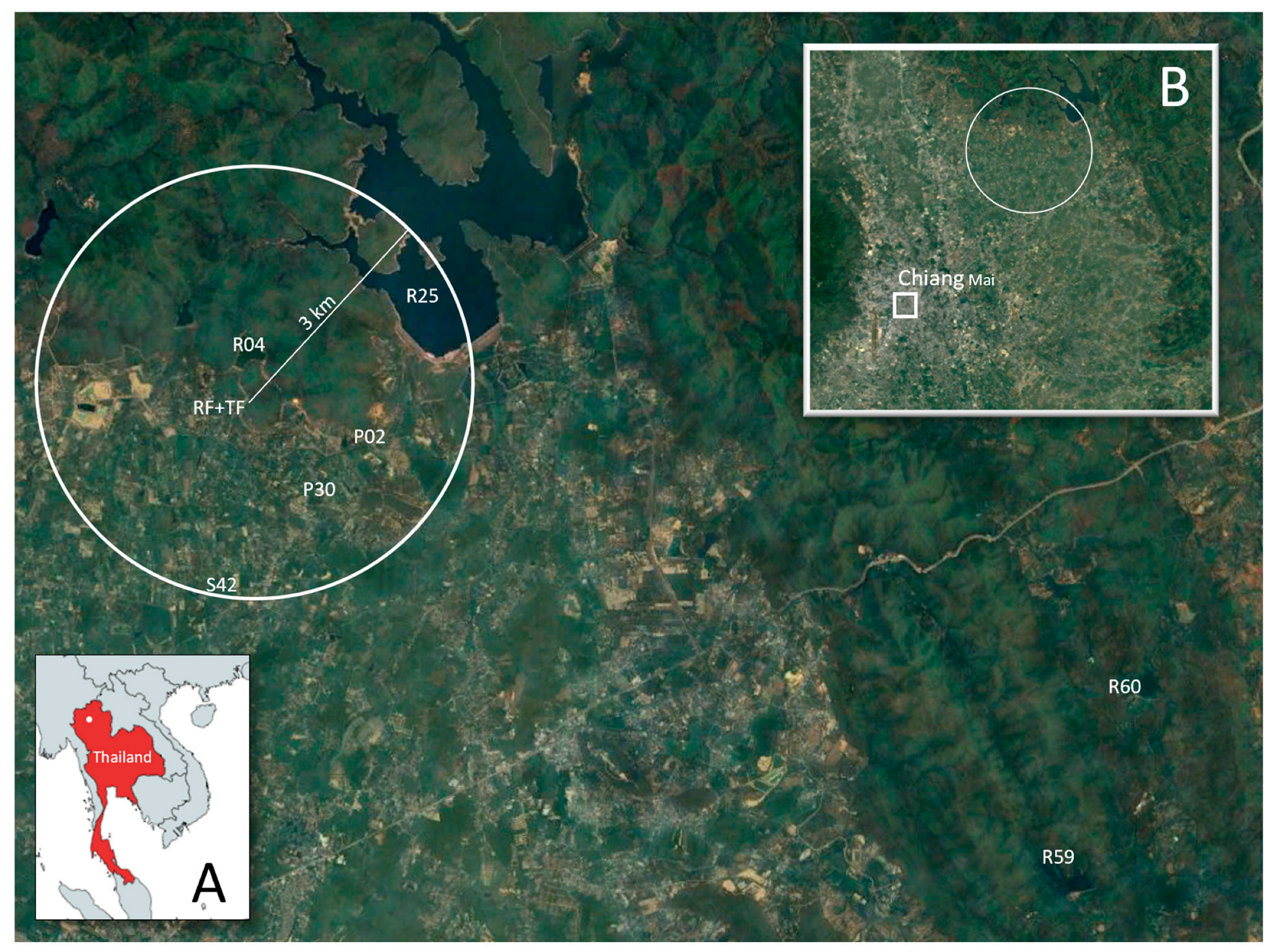
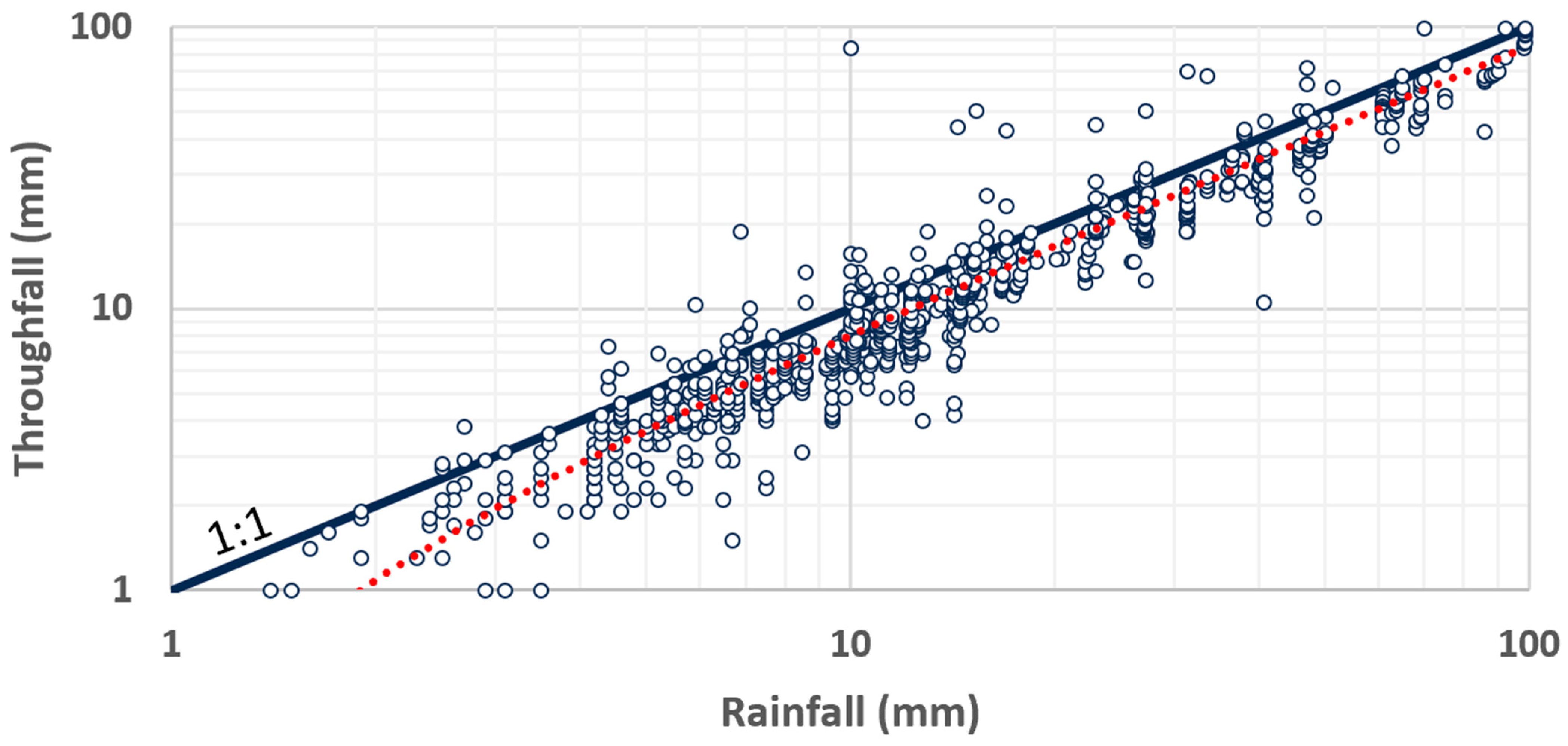
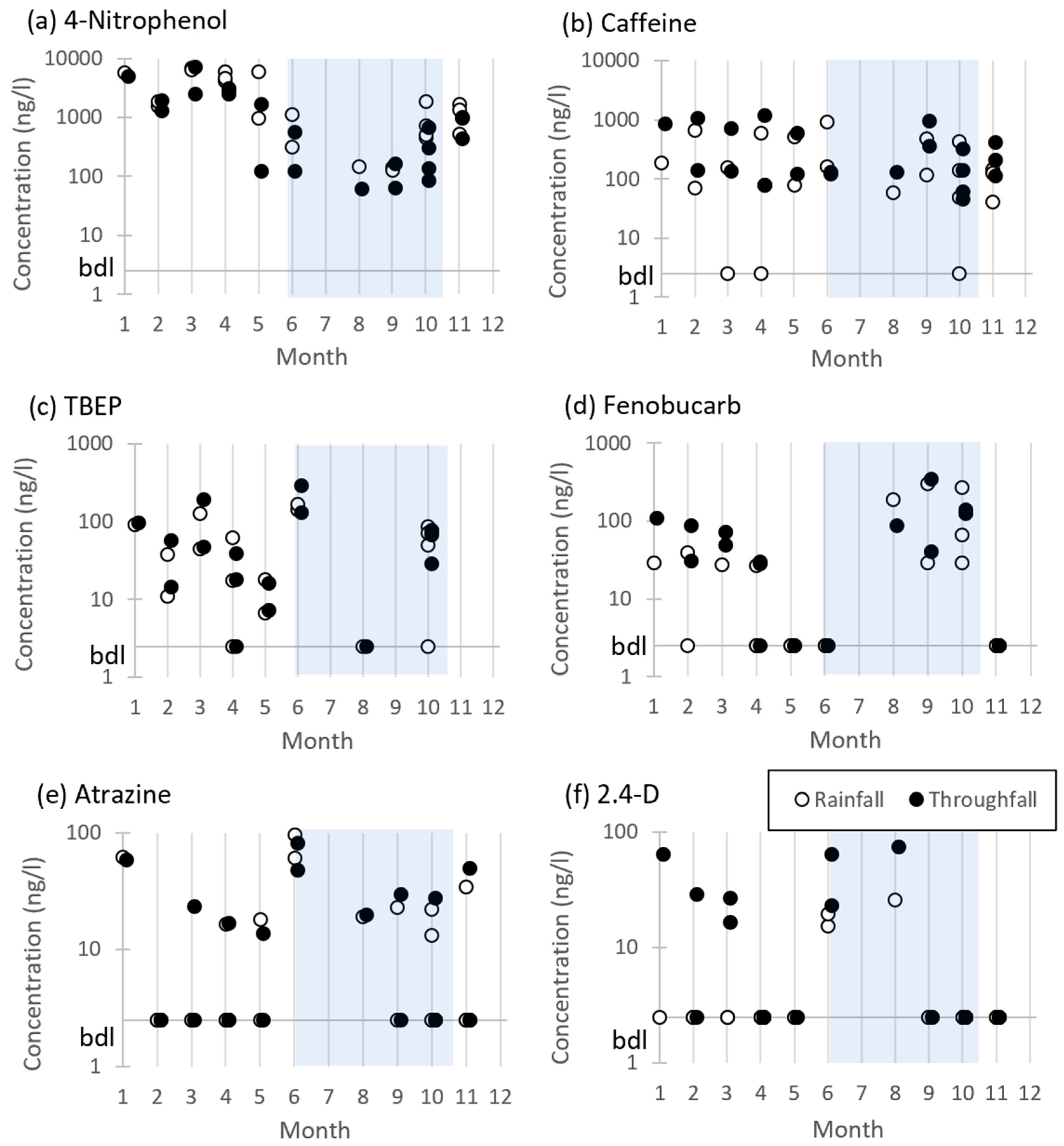
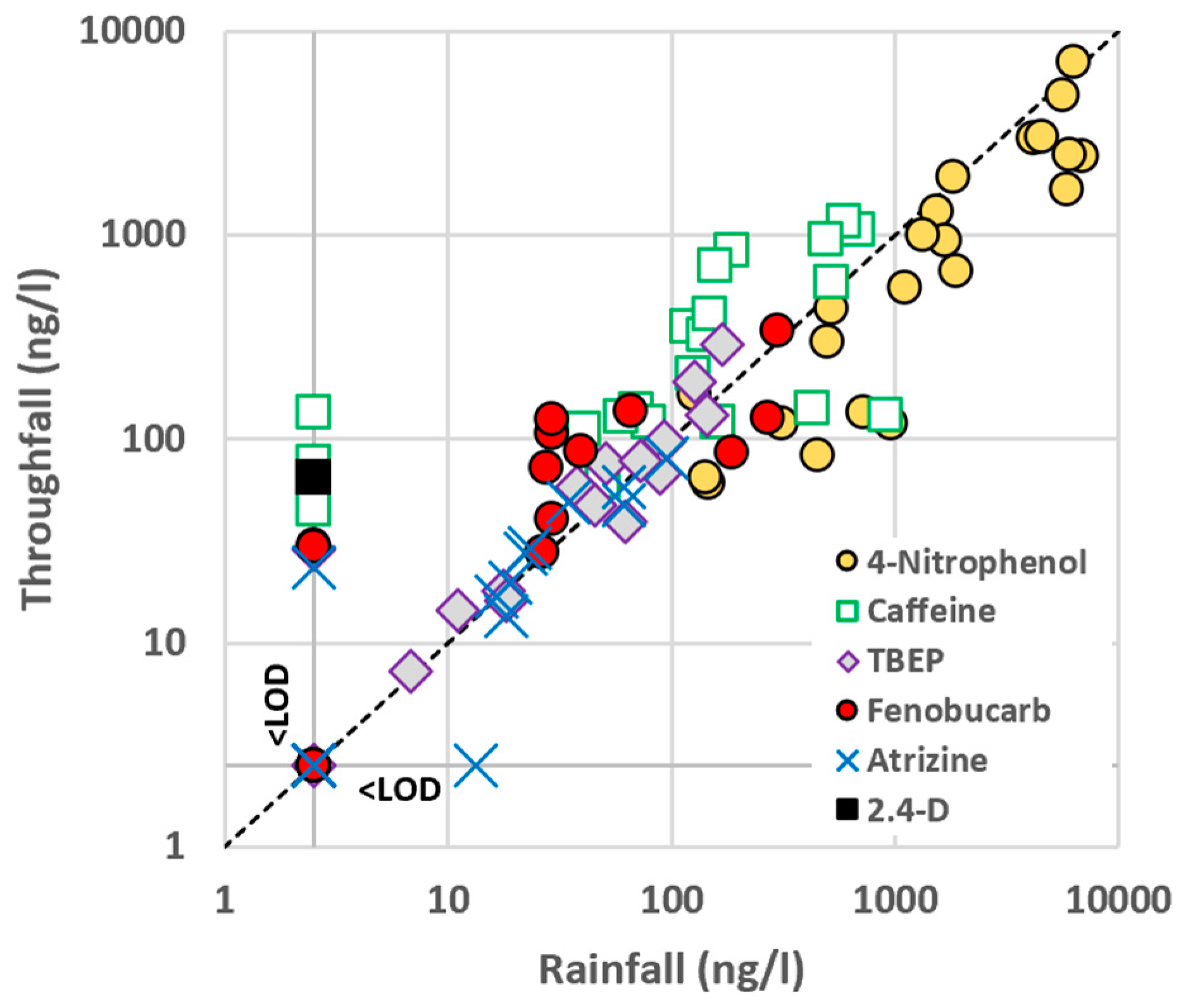
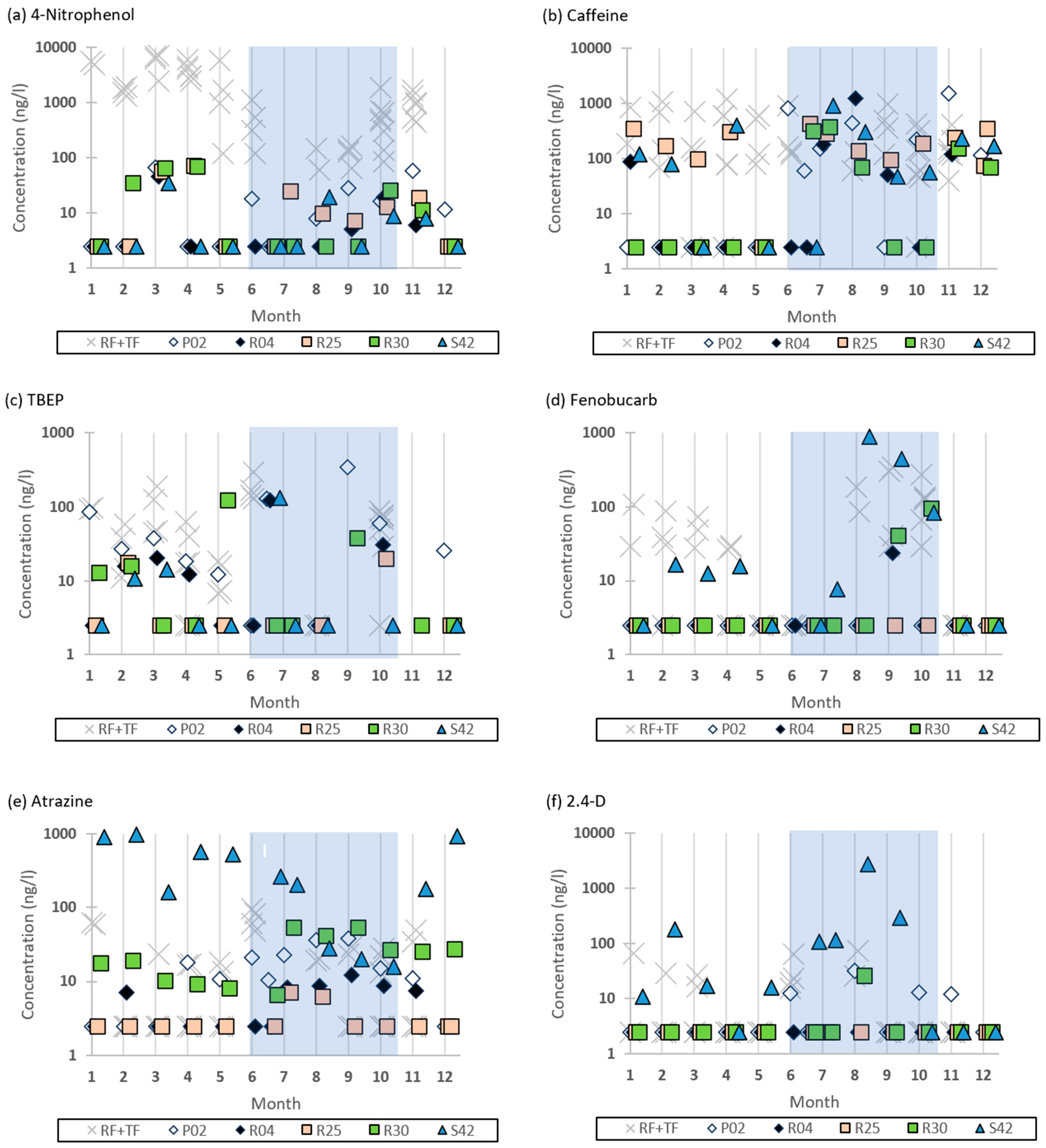
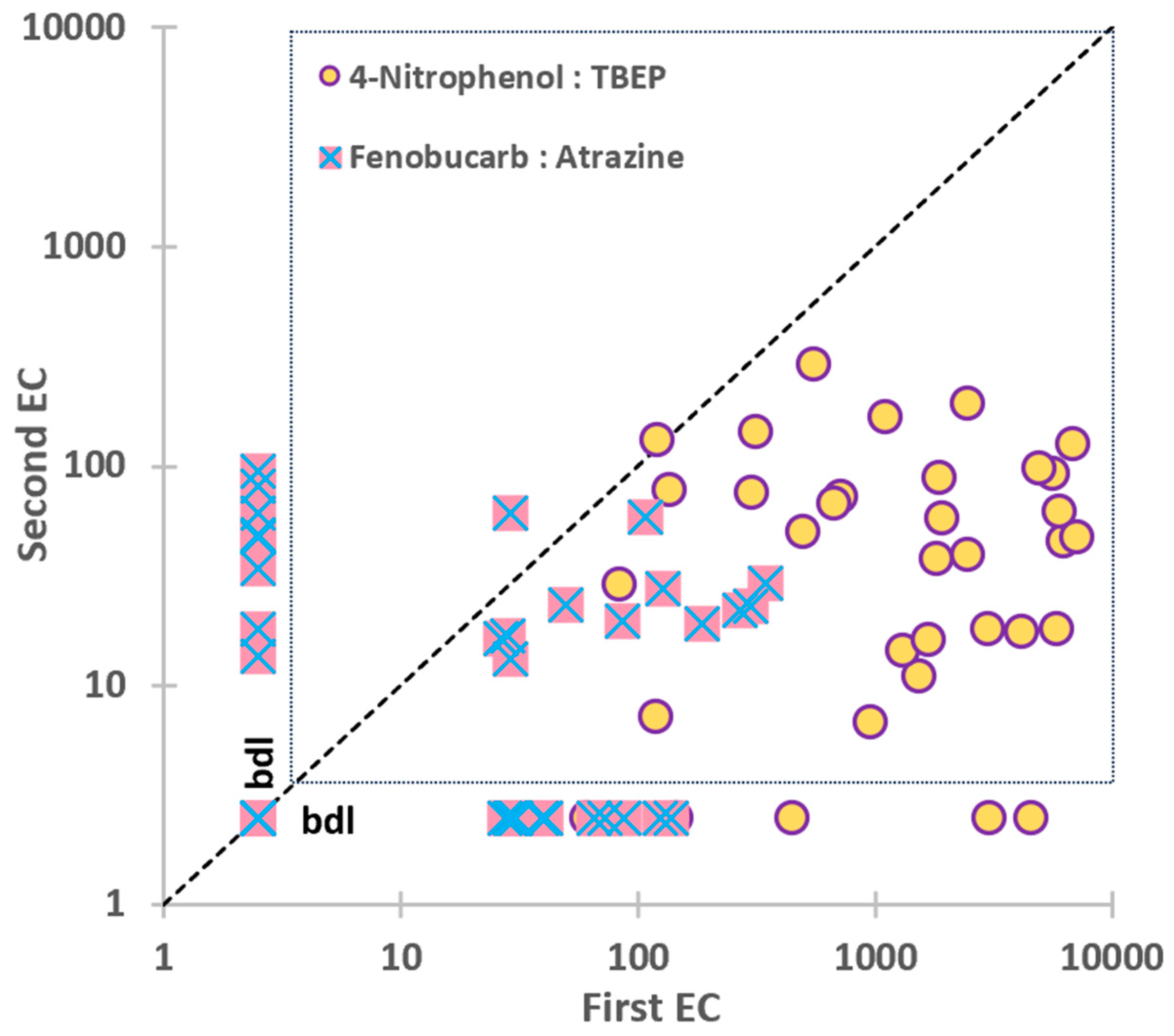
| Unit | Rainfall (ng/L) a | Throughfall (ng/L) a | Rho b | Field Banks f | |
|---|---|---|---|---|---|
| n | - | 22 | 22 | - | 44 |
| 4-Nitrophenol | ng/L | 1431 (6870) 1.0 | 810 (7127) 1.0 | 0.90 | Bdl e |
| Caffeine | ng/L | 133 (908) 0.82 | 141 (1176) 1.0 | 0.75 | bdl (553) g |
| TBEP | ng/L | 45 (168) 0.64 | 48 (292) 0.69 | 0.96 | bdl |
| Fenobucarb | ng/L | 13 (299) 0.46 | 30 (342) 0.60 | 0.88 | bdl |
| Atrazine | ng/L | bdl (95) 0.46 | bdl (81) 0.46 | 0.91 | bdl |
| 2,4-D | ng/L | bdl (26) 0.14 | bdl (74) 0.32 | ND d | bdl |
| Acetaminophen | ng/L | bdl (2054) 0.23 | bdl (1103) 0.05 | ND | bdl |
| Fexofenadine | ng/L | bdl | bdl (103) 0.14 | ND | bdl |
| Diphenhydramine | ng/L | bdl (208) 0.1 | bdl | ND | bdl |
| Gabapentin | ng/L | bdl | bdl (bdl–2059) 0.05 | ND | bdl |
| DOC | mg/L | 5.04 (2.48–1245) 1.0 | 22.07 (6.96–137.6) 1.0 | ND | ND |
| TN | mg/L | 0.48 (0.21–3.13) 1.0 | 0.75 (0.39–8.51) 1.0 | ND | ND |
| n (pH and SEC) | - | 101 | 64 | ND | ND |
| pH | - | 6.83 (5.08–8.71) | 6.15 (4.93–8.44) | ND | ND |
| SEC c | µS/cm | 8.2 (2–50) | 18.5 (2–105) | ND | ND |
| 4-Nitrophenol | Caffeine | TBEP | Fenobucarb | Atrazine | 2,4-D | |
|---|---|---|---|---|---|---|
| Pond (P02) | 8 (66) 0.54 | 59 (1532) 0.54 | 26 (344) 0.75 | bdl | 11 (38) 0.69 | 0 (32) 0.31 |
| Reservoir (R04) | bdl (46) 0.31 | bdl (1209) 0.46 | 12 (122) 0.55 | bdl (24) 0.08 | bdl (12) 0.46 | bdl |
| Reservoir (R25) | 8 (72) 0.58 | 210 (424) 0.92 | bdl (20) 0.20 | bdl | bdl (7) 0.17 | bdl |
| Pond (P30) | bdl (69) 0.42 | bdl (373) 0.42 | 6 (124) 0.50 | bdl (95) 0.17 | 22 (53) 1.00 | 0 (26) |
| Stream (S42) | bdl (35) 0.33 | 99 (896) 0.75 | bdl (131) 0.30 | 10 (875) 0.58 | 229 (970) 1.00 | 17 (2699) 0.67 |
| Reservoir (R59) | bdl (45) 0.25 | bdl (494) 0.38 | 6 (127) 0.50 | bdl | bdl (6) 0.13 | bdl |
| Reservoir (R60) | bdl (69) 0.33 | bdl (116) 0.44 | 13 (128) 0.57 | bdl | bdl (19) 0.45 | bdl |
Disclaimer/Publisher’s Note: The statements, opinions and data contained in all publications are solely those of the individual author(s) and contributor(s) and not of MDPI and/or the editor(s). MDPI and/or the editor(s) disclaim responsibility for any injury to people or property resulting from any ideas, methods, instructions or products referred to in the content. |
© 2023 by the authors. Licensee MDPI, Basel, Switzerland. This article is an open access article distributed under the terms and conditions of the Creative Commons Attribution (CC BY) license (https://creativecommons.org/licenses/by/4.0/).
Share and Cite
Lee, T.H.Y.; Srinuansom, K.; Snyder, S.A.; Ziegler, A.D. Atmosphere-Transported Emerging and Persistent Contaminants (EPCs) in Rainfall and Throughfall: Insights from a Rural Site in Northern Thailand. Atmosphere 2023, 14, 1603. https://doi.org/10.3390/atmos14111603
Lee THY, Srinuansom K, Snyder SA, Ziegler AD. Atmosphere-Transported Emerging and Persistent Contaminants (EPCs) in Rainfall and Throughfall: Insights from a Rural Site in Northern Thailand. Atmosphere. 2023; 14(11):1603. https://doi.org/10.3390/atmos14111603
Chicago/Turabian StyleLee, Theodora H.Y., Khajornkiat Srinuansom, Shane A. Snyder, and Alan D. Ziegler. 2023. "Atmosphere-Transported Emerging and Persistent Contaminants (EPCs) in Rainfall and Throughfall: Insights from a Rural Site in Northern Thailand" Atmosphere 14, no. 11: 1603. https://doi.org/10.3390/atmos14111603
APA StyleLee, T. H. Y., Srinuansom, K., Snyder, S. A., & Ziegler, A. D. (2023). Atmosphere-Transported Emerging and Persistent Contaminants (EPCs) in Rainfall and Throughfall: Insights from a Rural Site in Northern Thailand. Atmosphere, 14(11), 1603. https://doi.org/10.3390/atmos14111603






